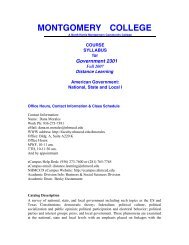2008 - Communication Across the Curriculum (CAC)
2008 - Communication Across the Curriculum (CAC)
2008 - Communication Across the Curriculum (CAC)
Create successful ePaper yourself
Turn your PDF publications into a flip-book with our unique Google optimized e-Paper software.
R a d i o l o g i c T e c h n o l o g y<br />
Services regularly reconsider <strong>the</strong>ir screening guidelines. “In<br />
<strong>the</strong> last 30 years, <strong>the</strong> American Cancer Society (ACS) has<br />
revised its breast cancer screening recommendations six<br />
times” (Schatz, 2007). Saliva tests, as well as <strong>the</strong> advent of<br />
magnetic resonance imaging, may imply an uncertain future<br />
for mammography as <strong>the</strong> primary screening tool for breast<br />
cancer, but will <strong>the</strong>se new methods replace <strong>the</strong> tradition of<br />
annual mammograms for women<br />
Magnetic resonance imaging is increasingly used for<br />
<strong>the</strong> detection and evaluation of breast cancer (Bremner &<br />
Recabaren, 2007). Accepted indications for <strong>the</strong> use of breast<br />
MRI include:<br />
1) axillary node metastases from suspected occult primary<br />
breast cancer, 2) monitoring response to neoadjuvant<br />
hormonal <strong>the</strong>rapy or chemo<strong>the</strong>rapy, 3) determining ipsilateral<br />
tumor extent or presence of contralateral disease in patients<br />
with proven invasive lobular breast cancer, 4) breast cancer<br />
screening for patients at very high risk for developing breast<br />
cancer, specifically those with suspected or proven mutations<br />
of BRCA one/two, and 5) additional evaluation of suspicious<br />
clinical findings or imaging results that remain inconclusive<br />
after complete mammographic and sonographic evaluations<br />
combined with physical exam (Bremner & Recabaren, 2007).<br />
MRI’s magnetic fields create excellent image contrast of<br />
<strong>the</strong> breast’s soft tissues when used in conjunction with an<br />
intravenous contrast agent called gadolinium (Schatz, 2007).<br />
Fur<strong>the</strong>rmore, “[T]he favorable sensitivity of MRI may help<br />
identify occult areas of breast cancer that are more extensive<br />
than appreciated on conventional mammography” (Bremner<br />
& Recabaren, 2007). Studies have shown that for patients<br />
already diagnosed with cancer “breast MRI more accurately<br />
defined <strong>the</strong> extent of tumor than did conventional imaging”<br />
(Bremner & Recabaren, 2007). Although several studies have<br />
demonstrated MRI’s superior ability to detect cancer, it does<br />
have disadvantages.<br />
One reason none of <strong>the</strong> nationally recognized advisory<br />
boards recommend breast MRI for women at average risk of<br />
developing breast cancer is <strong>the</strong> prevalence of false positives.<br />
“Because MRI is so good at picking up any abnormal tissue,<br />
8 3<br />
W r i t i n g A c r o s s t h e C u r r i c u l u m






